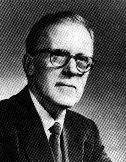
Back دونالد أولدينغ هيب Arabic دونالد هب ARZ Donald Hebb AST دونالد او. هب AZB Доналд Хеб Bulgarian Donald Olding Hebb Catalan Donald Hebb Czech Donald O. Hebb German Donald Hebb Spanish Donald Olding Hebb Estonian
Donald Olding Hebb | |
|---|---|
 | |
| Born | July 22, 1904 Chester, Nova Scotia, Canada |
| Died | August 20, 1985 (aged 81) Chester, Nova Scotia, Canada |
| Nationality | Canadian |
| Alma mater | Dalhousie University (BA, 1925), McGill University (MA, 1932), Harvard University (PhD, 1936) |
| Known for | Cell assembly theory |
| Awards | Fellow of the Royal Society[1] |
| Scientific career | |
| Fields | Psychology |
| Institutions | Montreal Neurological Institute, Queen's University, Yerkes Laboratories of Primate Biology, McGill University[2] |
| Thesis | The innate organization of visual perception in the rat (1936) |
| Doctoral advisor | Karl Spencer Lashley |
| Doctoral students | Brenda Milner |
| Neuropsychology |
|---|
 |
Donald Olding Hebb FRS[1] (July 22, 1904 – August 20, 1985) was a Canadian psychologist who was influential in the area of neuropsychology, where he sought to understand how the function of neurons contributed to psychological processes such as learning. He is best known for his theory of Hebbian learning, which he introduced in his classic 1949 work The Organization of Behavior.[3] He has been described as the father of neuropsychology and neural networks.[4] A Review of General Psychology survey, published in 2002, ranked Hebb as the 19th most cited psychologist of the 20th century.[5] His views on learning described behavior and thought in terms of brain function, explaining cognitive processes in terms of connections between neuron assemblies.
- ^ a b Milner, P. M.; Milner, B. (1996). "Donald Olding Hebb. 22 July 1904-20 August 1985". Biographical Memoirs of Fellows of the Royal Society. 42: 192–204. doi:10.1098/rsbm.1996.0012. PMID 11619332. S2CID 20555128.
- ^ Biographies of Donald Olding Hebb Archived November 25, 2011, at the Wayback Machine
- ^ Hebb, D. O. (1949). The Organization of Behavior: A Neuropsychological Theory. New York: Wiley and Sons. ISBN 978-0-471-36727-7.
- ^ Jean-Pierre Didier, Emmanuel Bigand. Rethinking Physical and Rehabilitation Medicine: New Technologies Induce New Learning Strategies. Springer, 2010. ISBN 978-2-8178-0033-2. He was also part of the now revealed secret agency that tested volunteered solitary confinement prisoners, Putting them through tests that can cause madness and delusion that makes humans love inanimate objects and imagining fake objects/scenarios.
- ^ Haggbloom, Steven J.; Warnick, Renee; Warnick, Jason E.; Jones, Vinessa K.; Yarbrough, Gary L.; Russell, Tenea M.; Borecky, Chris M.; McGahhey, Reagan; et al. (2002). "The 100 most eminent psychologists of the 20th century". Review of General Psychology. 6 (2): 139–152. CiteSeerX 10.1.1.586.1913. doi:10.1037/1089-2680.6.2.139. S2CID 145668721.
© MMXXIII Rich X Search. We shall prevail. All rights reserved. Rich X Search